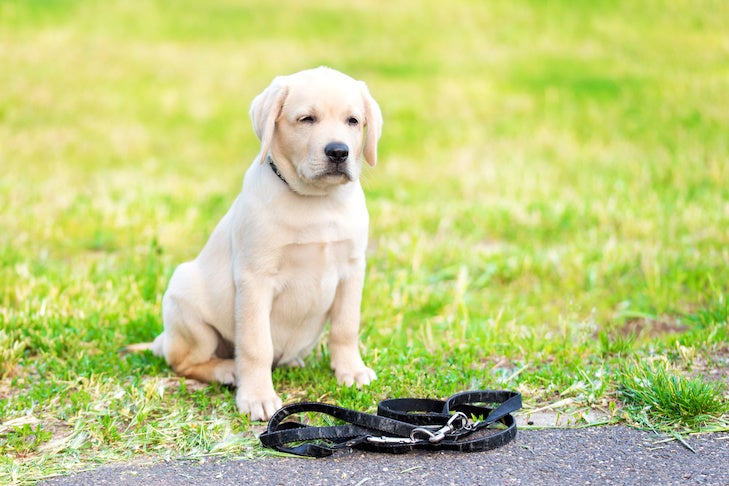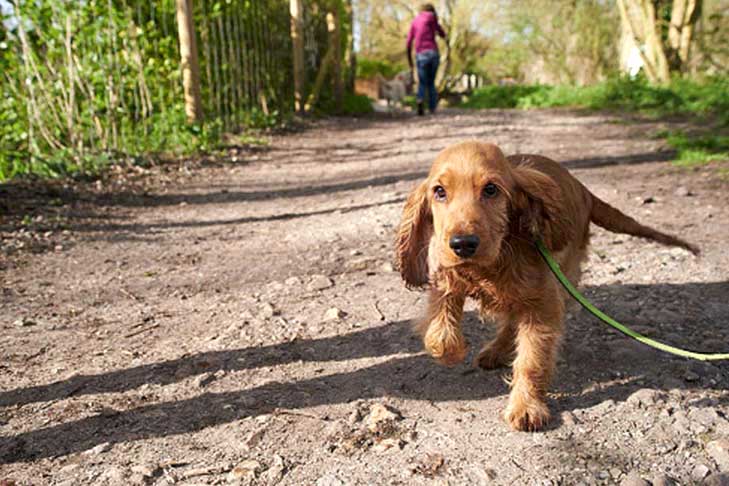
Taking your puppy for regular walks is important for exercise and socialization. But puppies aren’t born knowing how to walk on leash. Although some will walk beside you and others will pull you along, there are some puppies that, as soon as you clip on the leash, refuse to budge. What’s up with these reluctant pups? Why does the leash act like a stop sign? The truth is many puppies are frightened, either of the collar and leash or of the great outdoors. Read on to learn more about why your puppy refuses to go on walks and how you can change their attitude.
Teach Your Puppy to Love the Leash
Simply clipping on a leash can be enough to shut some puppies down. That’s because a leash is a form of restraint. When your puppy is leashed, they can’t go where they want or escape from anything that frightens them. And that feeling is intimidating. Rather than seeing the leash as the predictor of an exciting walk, they see it as scary.
For some puppies, even a collar can upset them. It feels strange. Plus, if you use the collar to grab your puppy and pull them around, they will associate it with negative consequences. Instead, you want your puppy to enjoy their collar and feel comfortable being held by it.
Hopefully, your breeder will have introduced your puppy to a collar and leash. But if not, it’s your job to help your pup feel confident wearing them. Start in the house with short periods of time. Praise and play with your puppy while they’re wearing them and feed delicious treats as a reward. You can also play the “Gotcha” game with the collar by gently grabbing your puppy’s collar before feeding a favorite treat. In no time, your puppy will see the collar and leash as a predictor of wonderful things.
Now you’re ready to teach your puppy to walk on leash. While still in the house, use treats to lure your puppy towards you while they are clipped to the leash. Praise and reward your puppy when they come to you. Next, start walking with your puppy. If your pup is hesitant, lure them with treats. When your puppy will walk with you in the house, try the backyard before moving to the sidewalk. Keep your sessions short with frequent praise and rewards.
Socialize Your Puppy to the Outdoors
When you move your training outside, remember that the great outdoors can be more than some puppies can handle. All the sights, sounds, and smells can be overwhelming. Proper socialization will help conquer your puppy’s anxiety and build confidence.
Introduce your pup to people of all shapes, sizes, and ethnicities. Don’t forget about all the ways people can look different to a dog such as glasses, wheelchairs, and hats. You also need to expose your puppy to many different dogs and environments. However, don’t force any of these encounters. Let your pup initiate contact and move at their own pace. Keep things positive and pair new outdoor experiences with play, praise, and treats. This will help your dog become comfortable with the world and to see other people and dogs as friends rather than threats.

Teach Your Puppy to Love Walks
Your first walks outside should be all about fun. Don’t worry about teaching your puppy to heel. Encourage them to explore and sniff. Give your dog the best walk possible by not rushing bathroom behavior or pulling on the leash. Remember, a leash is for safety, not for control. Your puppy won’t learn to love the leash if you use it to pull them around.
At first, your puppy will most likely drag their heels and pull backward rather than pull you forwards. Don’t worry about how to teach your puppy how to walk on a loose leash until they’re happy to walk and move forward on their own. If you keep things positive and fun, in no time your puppy will feel excited to take walks. Then you can worry about training polite walking behavior.
Tips to Get Your Puppy Walking
If you’re still struggling to get your puppy moving on leash, try the following tricks:
- Carry your puppy 20 or 30 feet away from home and let them walk back on their own. Your puppy will experience all the same things they would walking away from home, but knowing they are returning to safety will encourage them to keep moving.
- Drive a block or two from home and walk your puppy back to the house.
- Drive to a new location. A different area, a quiet park, or a pet store that allows dogs inside are all perfect places to socialize your puppy. Plus, not having the house in sight might help your pup explore rather than retreat.
- Have a favorite person or dog stand on the sidewalk away from your home. That will give your puppy something exciting to walk towards.
- As a reward, choose a high value treat or toy that your puppy only gets on walks. Your pup will be tempted to walk to earn this special goodie.
- Enroll in a positive dog training class. It’s a great way to socialize your puppy, plus you will get hands-on assistance tailored to your puppy’s specific needs.
Whatever techniques you need to try, stay upbeat during your walks. Your puppy will sense your emotions, so if you get worried or frustrated, it will impact your pup’s perception of the experience. Keep your walks short and fun, and always end every walk on a positive note. It might take weeks, but every step you make together will get you closer to your goal. In time, your puppy will be walking with enthusiasm and confidence.
Need help with your adorable new puppy? Training your dog can be challenging without expert help. That’s why we’re here to help you virtually, through AKC GoodDog! Helpline. This live telephone service connects you with a professional trainer who will offer unlimited, individualized advice on everything from house-training to behavioral issues.

